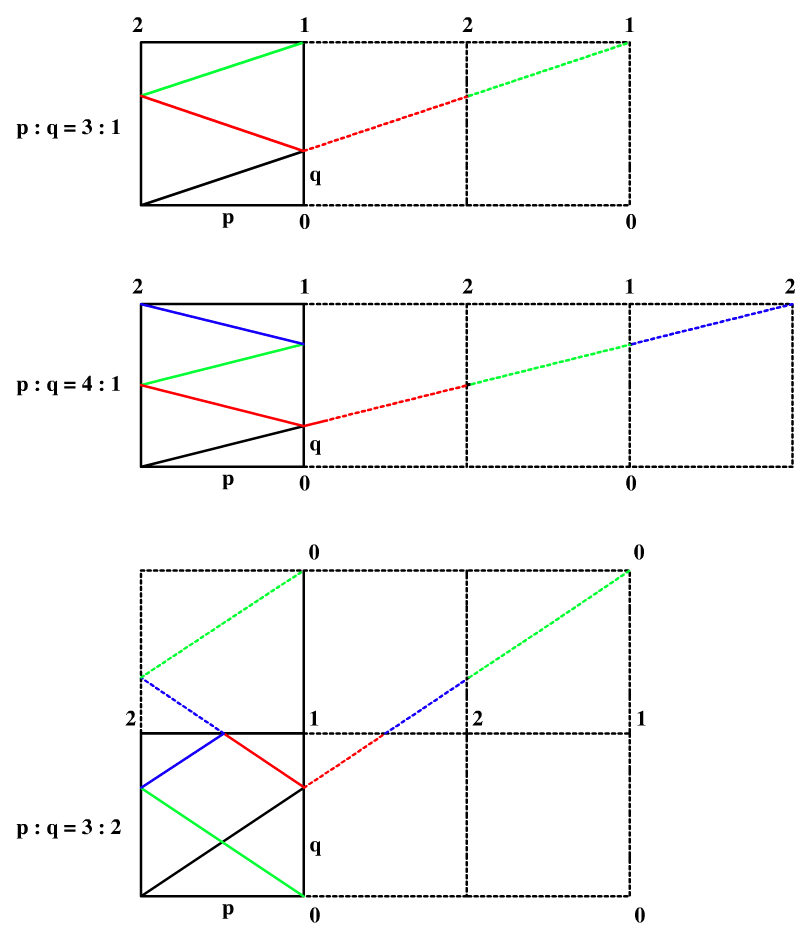[LeetCode] 858. Mirror Reflection 镜面反射
There is a special square room with mirrors on each of the four walls. Except for the southwest corner, there are receptors on each of the remaining corners, numbered `0`, `1`, and `2`.
The square room has walls of length p, and a laser ray from the southwest corner first meets the east wall at a distance q from the 0th receptor.
Return the number of the receptor that the ray meets first. (It is guaranteed that the ray will meet a receptor eventually.)
Example 1:
Input: p = 2, q = 1
Output: 2
Explanation: The ray meets receptor 2 the first time it gets reflected back to the left wall.

Note:
1 <= p <= 10000 <= q <= p
这道题给了我们一个正方形的房间,说是四面都是镜子墙,然后在西南角有一个激光发射器,其余三个角都有接收装置,问我们最终激光会被哪个接收器接收。第一次读题时这句 "Return the number of the receptor that the ray meets first." 让博主理解错误了,以为是让返回接收器的个数,以为接收器也能反射激光到其对角的接收器,那么接收器2和0互相反射,就是返回经过了2个接收器,接收器1返回到反射点,就是返回经过了1个接收点,想的是一套一套的,结果人家让返回的是接收器的标号,个人觉得将 number 改为 index 会减少些歧义。无所谓了,反正最终搞懂了题意就行了。其实这道题的正确解法还挺难想的,因为大家很容易走进的误区就是研究反射角啥的,然后算具体反射到了哪一个位置,再算下一个位置,其实这样都将题目变复杂了。博主把这一类型归为脑筋急转弯 Brain Teaser,一般都有很巧妙的数学解法,并不需要太复杂的算法。
首先从最简单的情况开始分析,当p和q相等的时候,那么激光直接到达接收器1,当 p/q = 2 的时候,就如例子中所示,经过右边的镜面反射后到达左上角的接受器2。那么我们再来考虑下这三种情况 p/q = 3, p/q = 4, p/q = 3/2,并画出折射情况如下所示:

这里就有些比较好玩的规律了,我们知道激光遇到镜面是会发生折射的,但是假如没有镜面,就会仍然沿直线前进,那么对于 p/q = 3 时,若我们在右边增加大小相同的2个房间,则激光会到达右上角,由于第二个房间和原始房间是镜面对称的,而第三个房间和第二个房间也是镜面对称的,则第三个房间和原始房间就是一样的了,那么就可以假设一下,奇数房间和原始房间的布局相同。再来看上图中的 p/q = 4 时,我们在右边复制了三个房间,在第四个房间的时候,激光到达了右上角,而第偶数个房间的布局是跟原始房间称镜面反射的,则就是接受器2了。其实有些时候,我们不止要在右边复制房间,还需要在上面复制房间,比如当 p/q = 3/2 时,我们需要复制出一个 2x3 大小的矩阵出来,在水平方向共有三个房间,是奇数则水平方向和原始房间布局一致,但是竖直方向也复制了房间,那么竖直方向有偶数个房间,则竖直方向和原始房间成镜面反射,则最右上角为接收器0。
分析到这里,我们应该已经能总结出规律如下了:
- p为奇数,q为奇数时,到达接收器1。
- p为奇数,q为偶数时,到达接收器0。
- p为偶数,q为奇数时,到达接收器2。
那你可能会有疑问了,为啥没有p和q均为偶数的情况呢?比如 p = 4, q = 2,其实只要我们画个图就知道,这个跟 p = 2, q = 1 的情况是一摸一样的,若p和q均为偶数,那么那么一定可以同时除以2,那么其实我们可以先对p和q进行判断,若二者同为偶数,则同时除以2,直到不同时为偶数时,然后再带入上面归纳的三种情况求解即可,参见代码如下:
解法一:
class Solution {
public:
int mirrorReflection(int p, int q) {
while (p % 2 == 0 && q % 2 == 0) {
p /= 2; q /= 2;
}
if (p % 2 == 0) return 2;
if (q % 2 == 0) return 0;
return 1;
}
};
其实我们可以进一步化简,将三种情况融为一个表达式即可,即 1 - p%2 + q%2,不信的话可以带数字验证一下,碉堡了有木有,参见代码如下:
解法二:
class Solution {
public:
int mirrorReflection(int p, int q) {
while (p % 2 == 0 && q % 2 == 0) {
p /= 2; q /= 2;
}
return 1 - p % 2 + q % 2;
}
};
其实不光是p和q同时为偶数的时候可以化简,只要p和q的最大公约数 Greatest Common Divisor 大于1时,都可以化简,比如,若 p = 6, q = 3 时跟 p = 2, q = 1 的情况也是一样,那我们就可以先求出p和q的最大公约数,然后用p和q分别除以这个最大公约数,再带入上面的那个一行公式求解即可,参见代码如下:
解法三:
class Solution {
public:
int mirrorReflection(int p, int q) {
return 1 - p / gcd(p, q) % 2 + q / gcd(p, q) % 2;
}
int gcd(int p, int q) {
return q ? gcd(q, p % q) : p;
}
};
Github 同步地址:
https://github.com/grandyang/leetcode/issues/858
参考资料:
https://leetcode.com/problems/mirror-reflection/
[LeetCode All in One 题目讲解汇总(持续更新中...)](https://www.cnblogs.com/grandyang/p/4606334.html)







 浙公网安备 33010602011771号
浙公网安备 33010602011771号